Motivation. C h a p te r 1
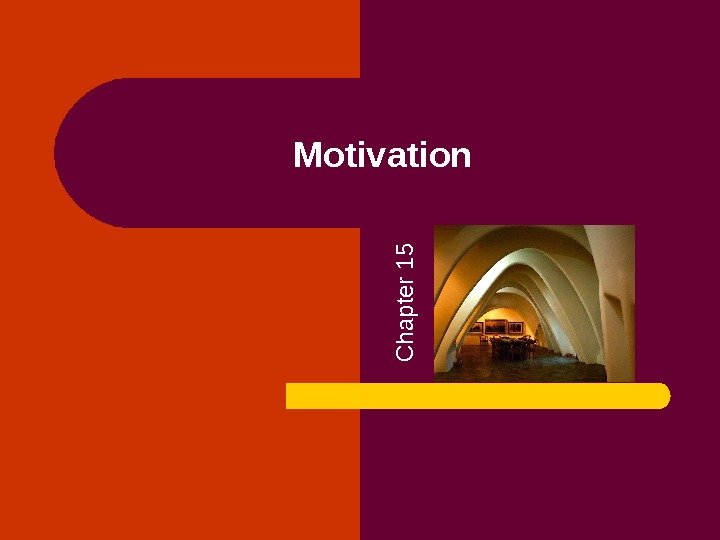
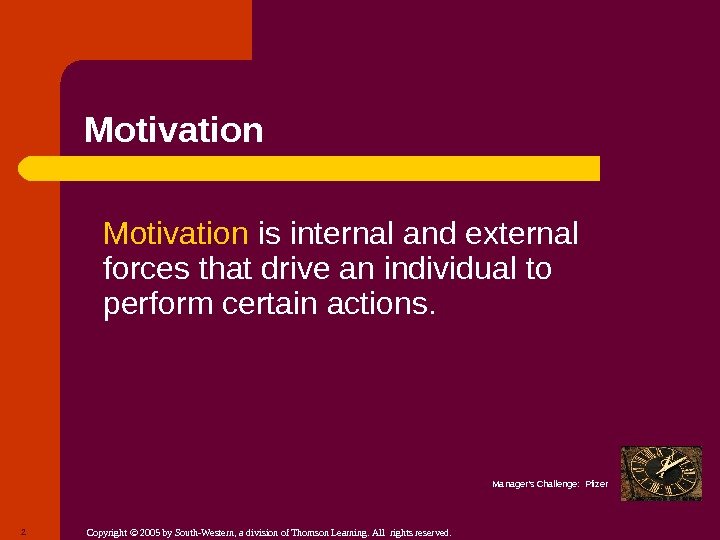
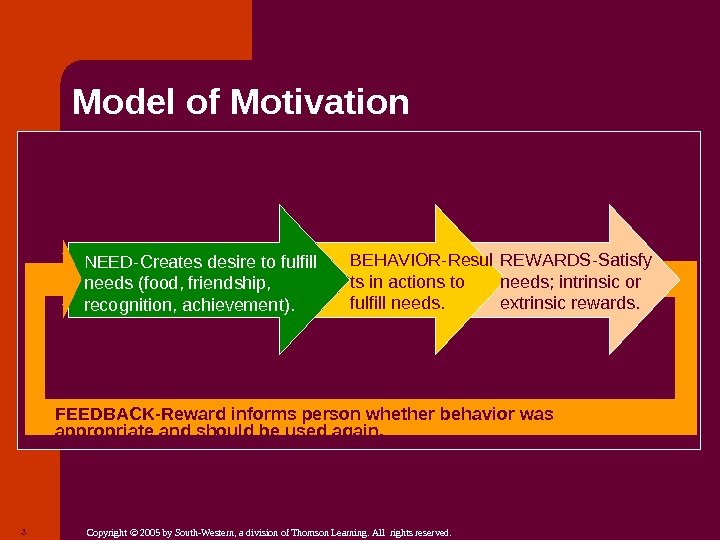
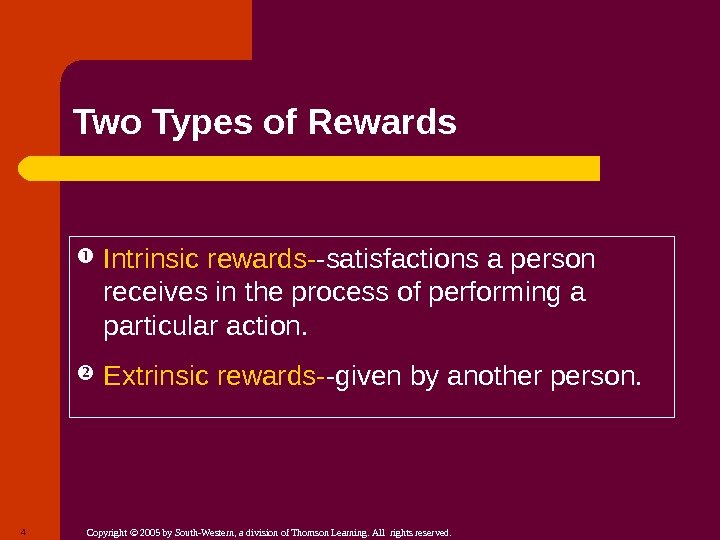

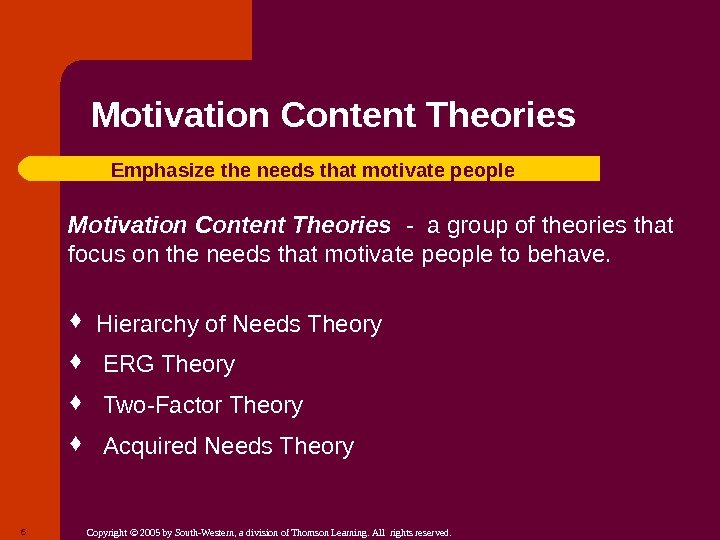
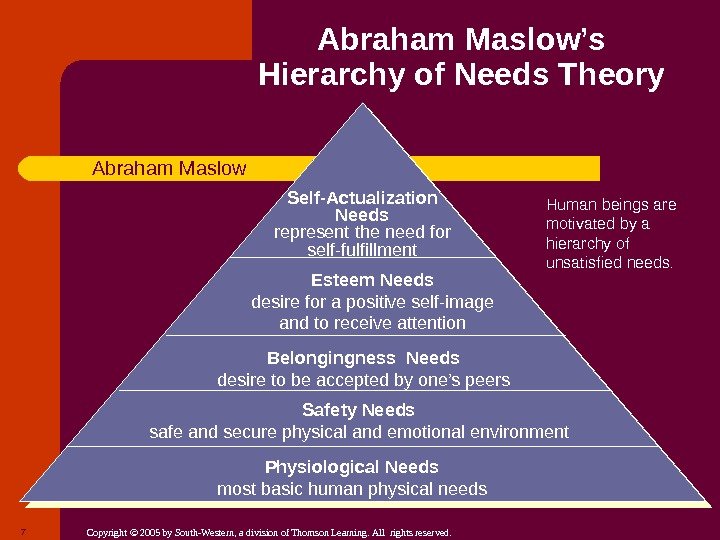

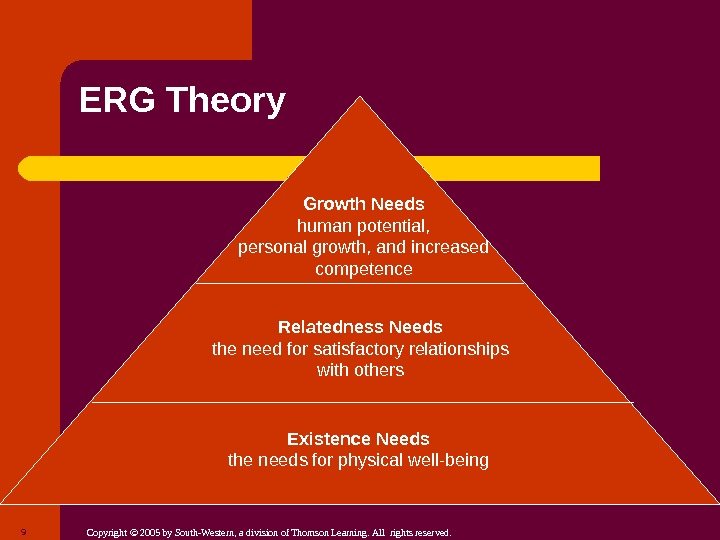
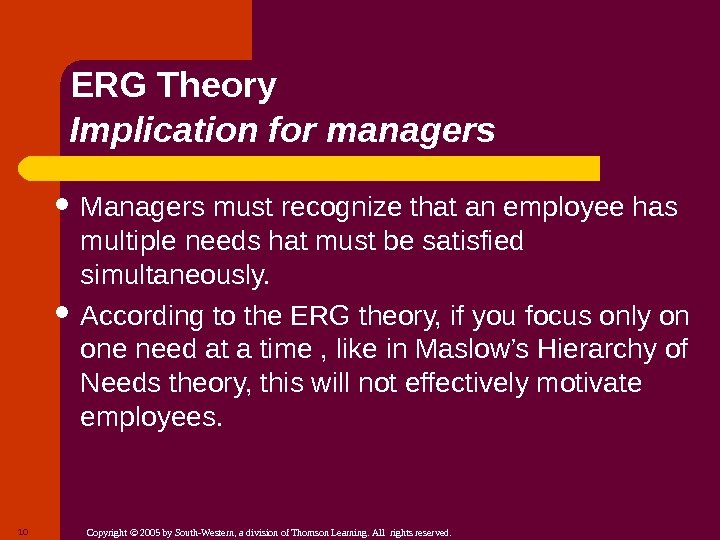
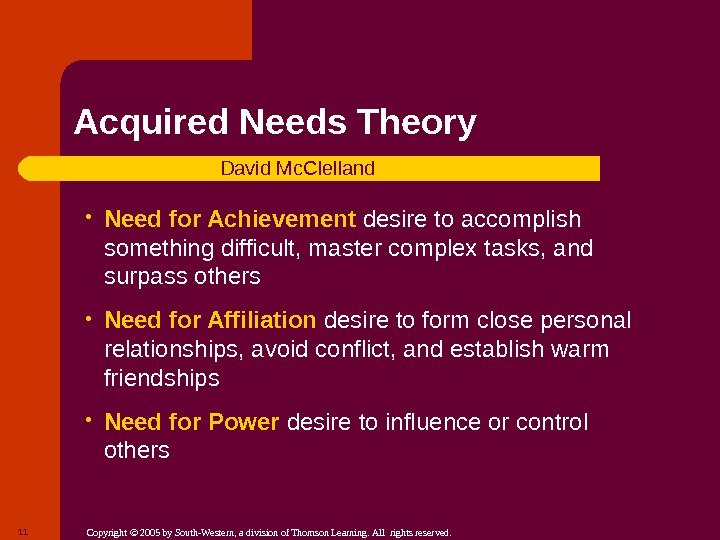
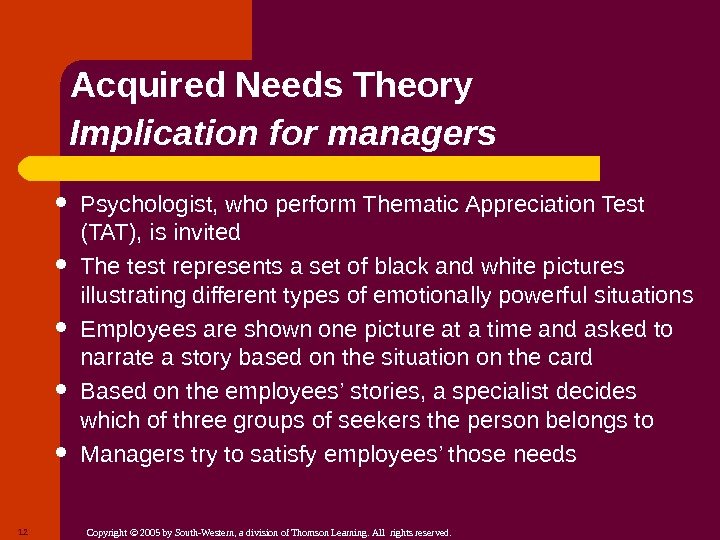
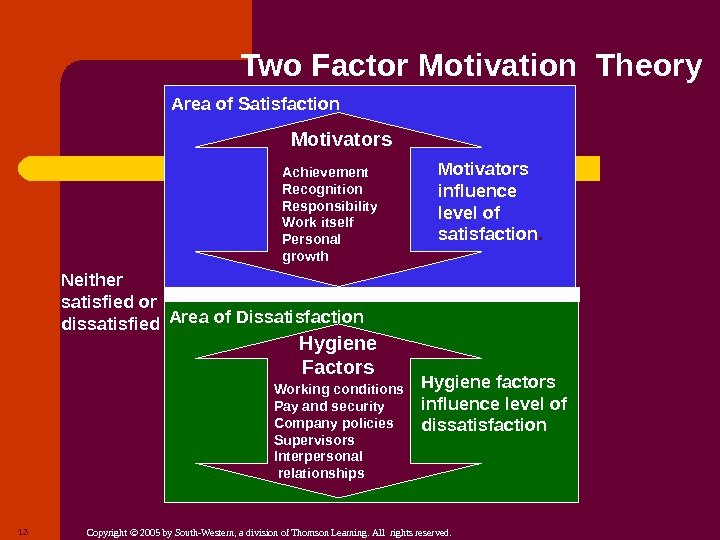
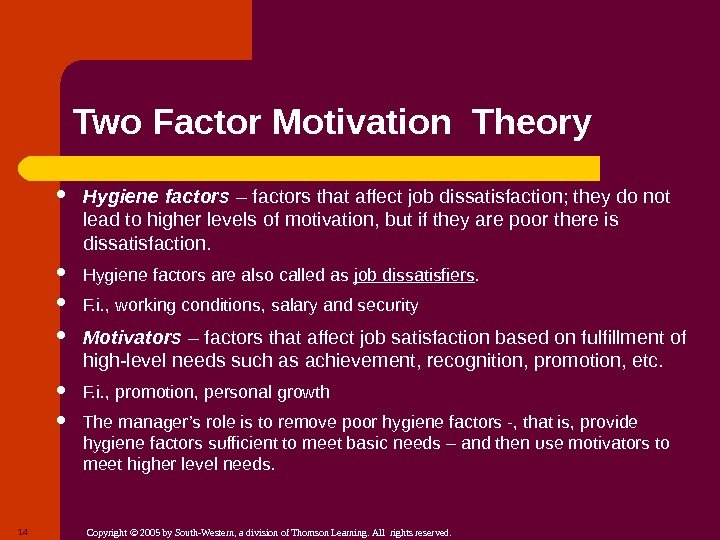
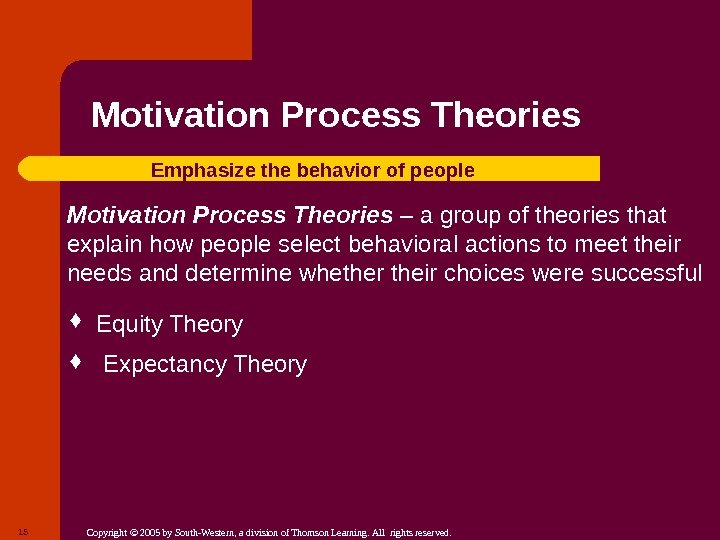
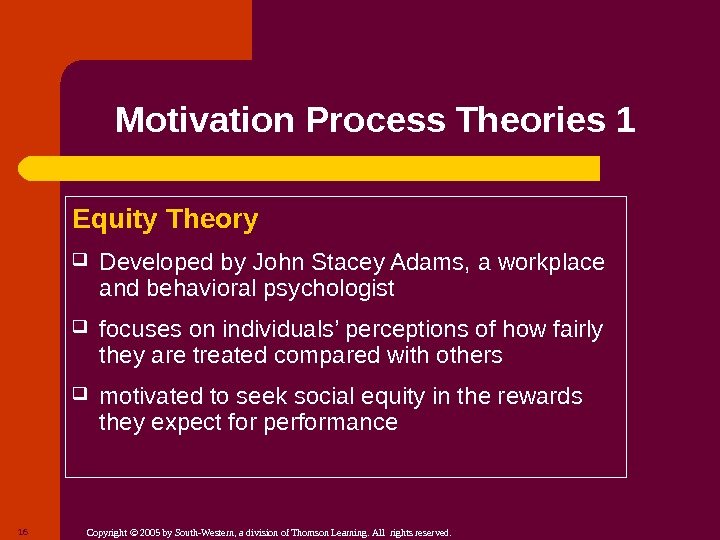
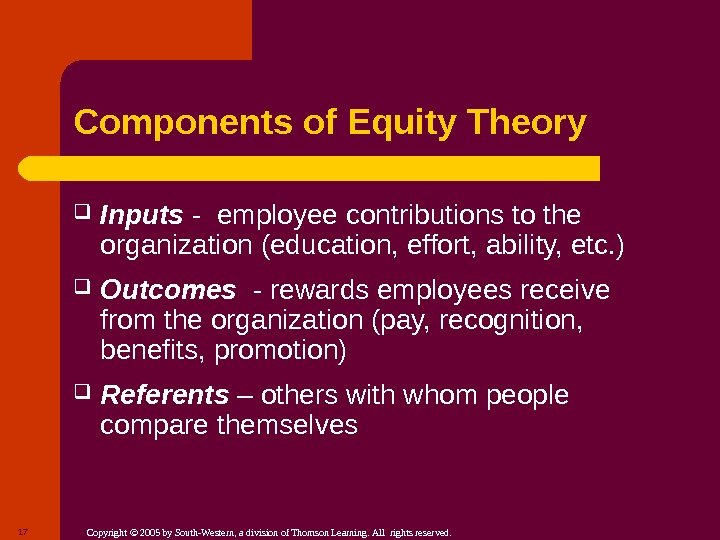
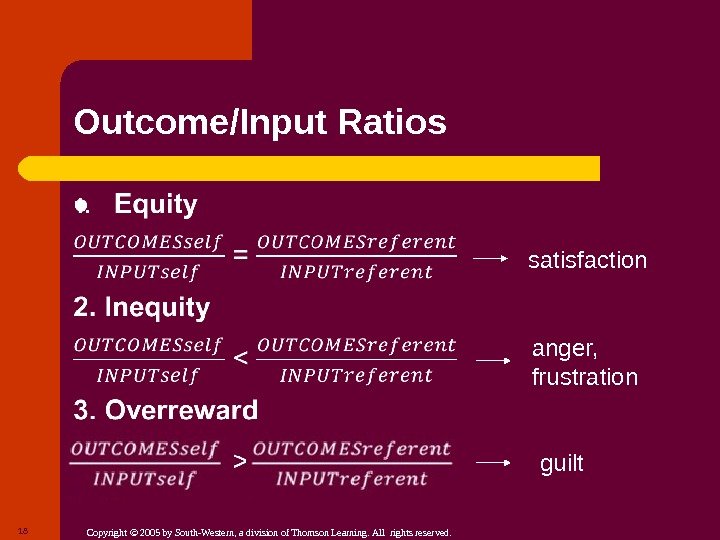
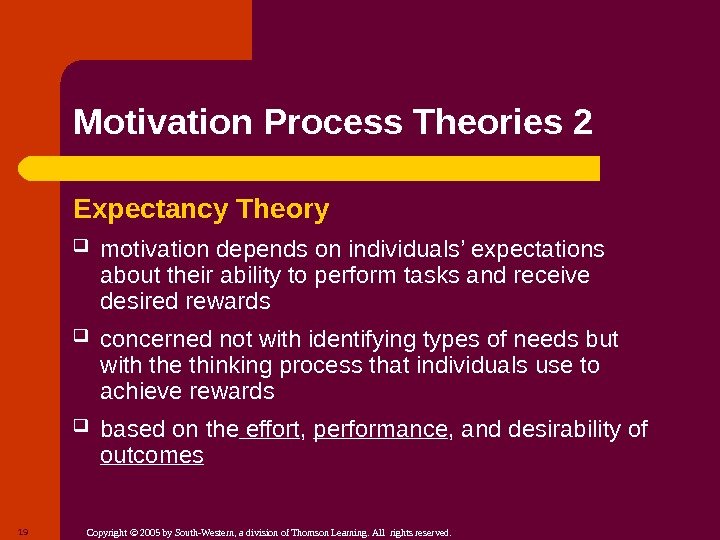
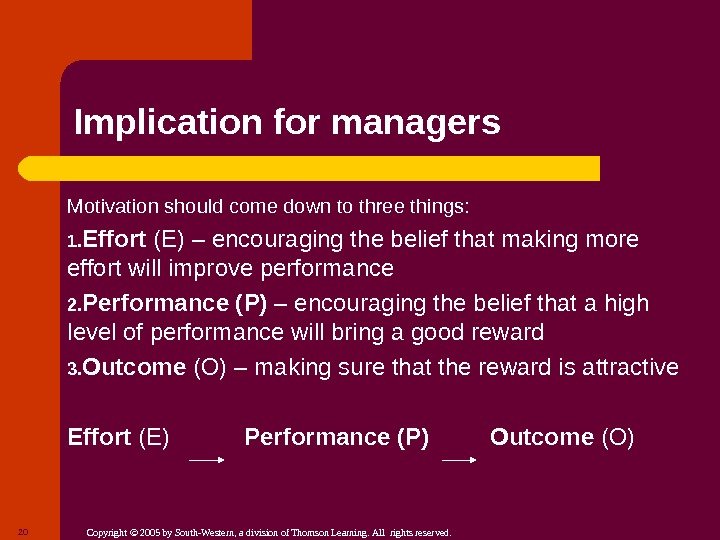
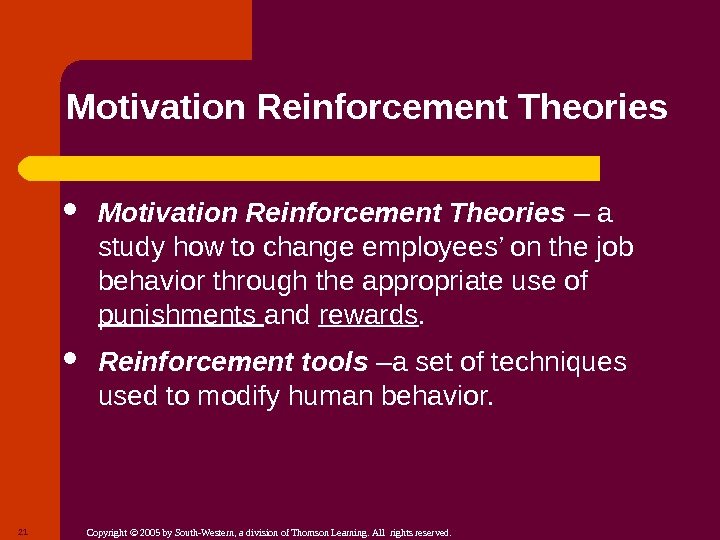
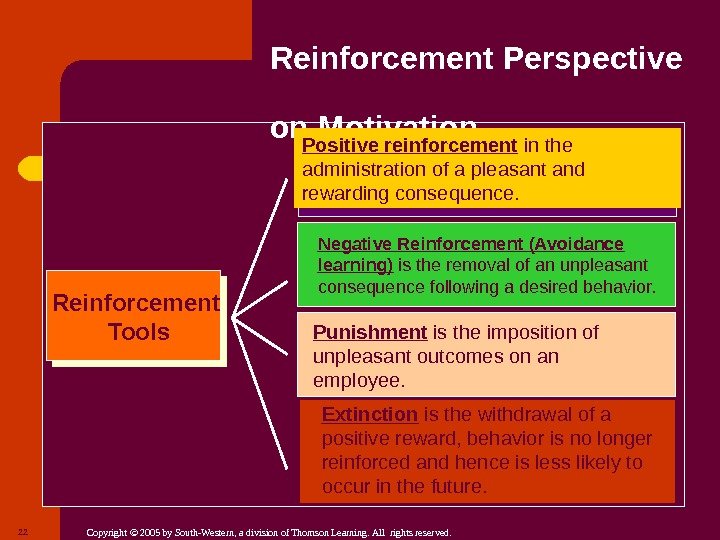
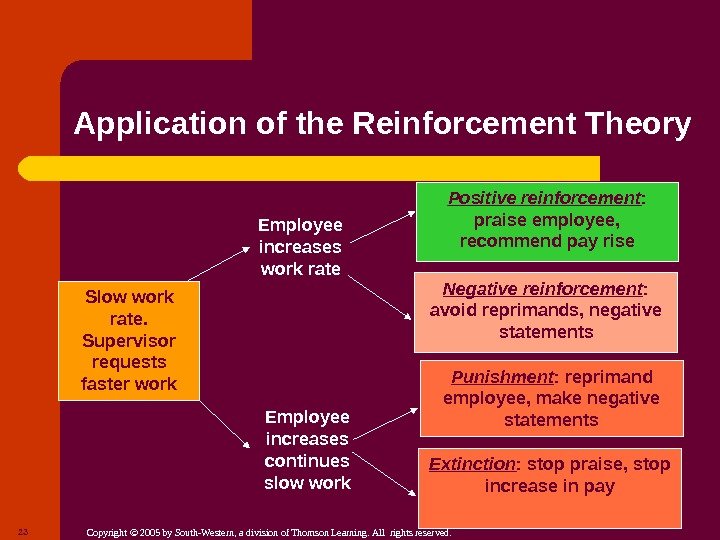
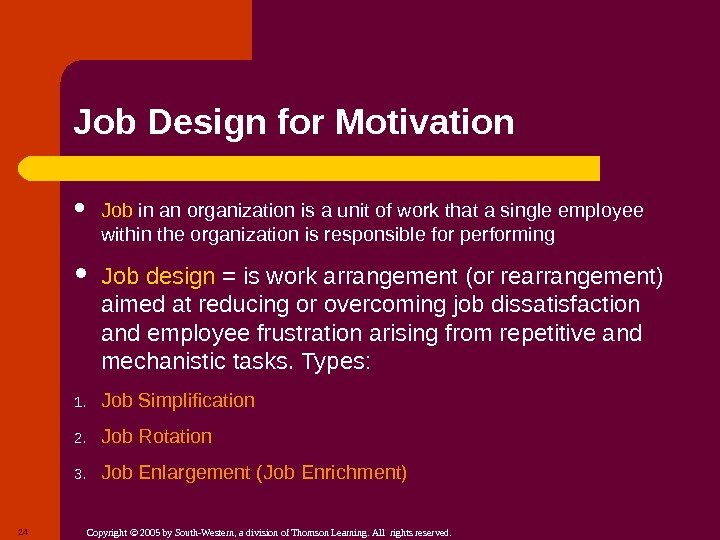
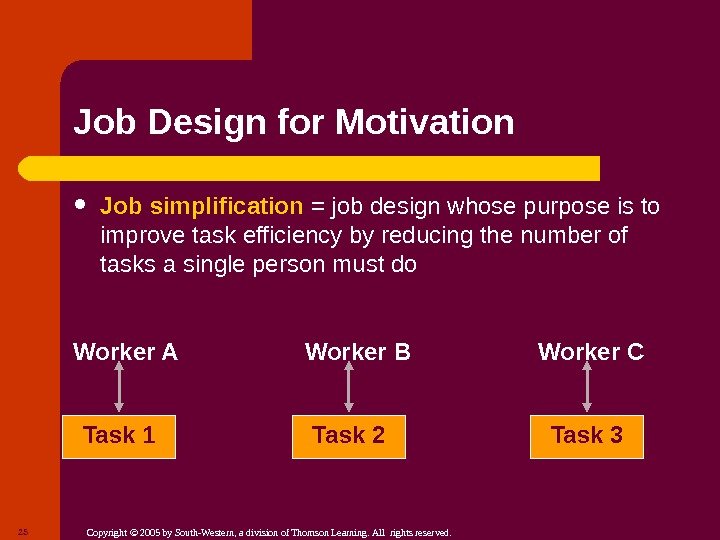
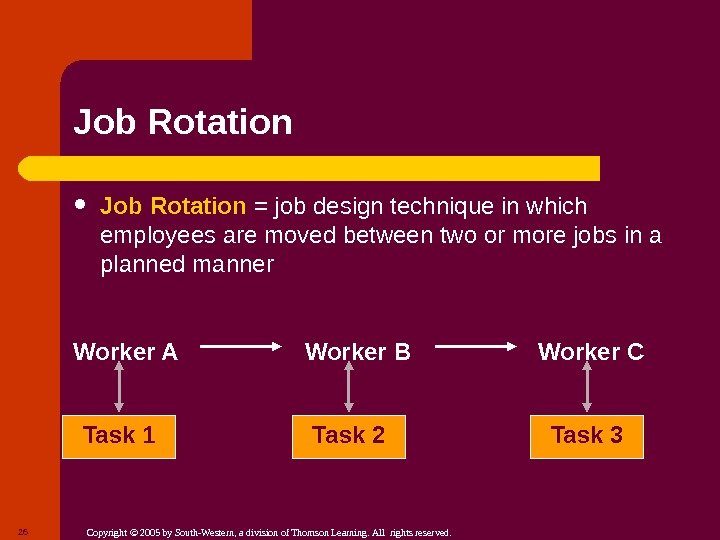
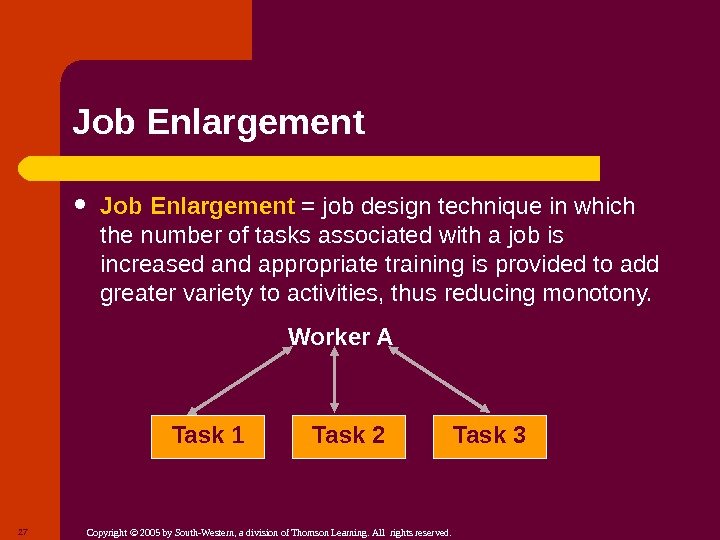
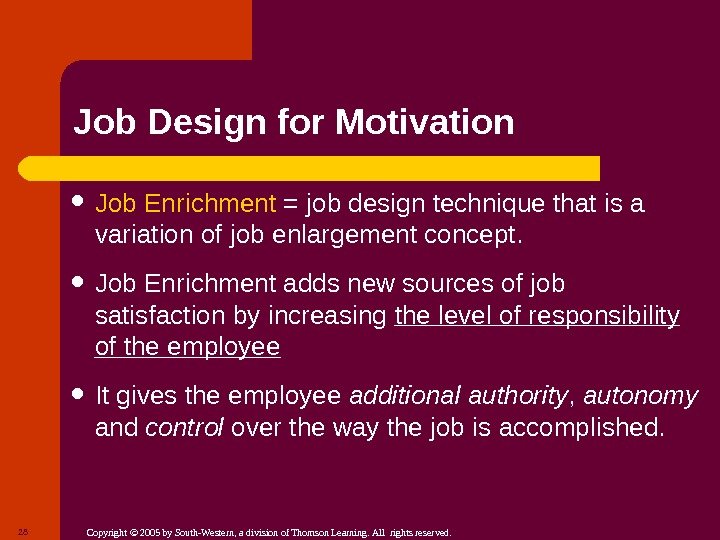
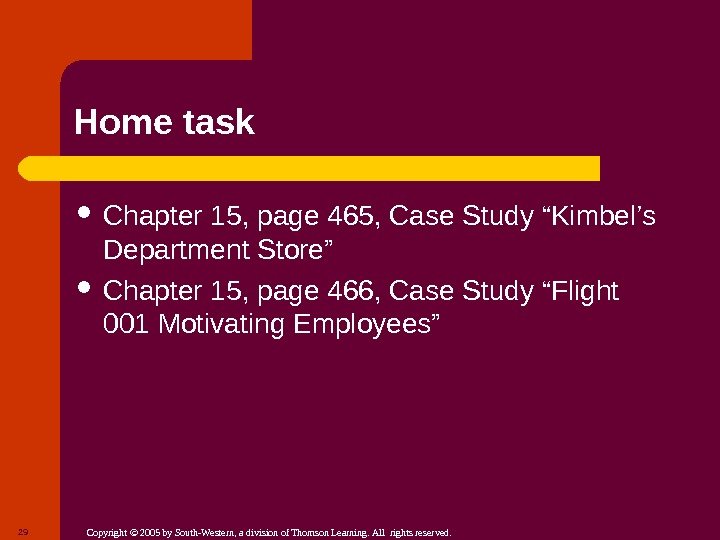
ch_15_motivation.ppt
- Размер: 1.0 Мб
- Автор:
- Количество слайдов: 29
Описание презентации Motivation. C h a p te r 1 по слайдам
 Motivation. C h a p te r
Motivation. C h a p te r
 Copyright © 2005 by South-Western, a division of Thomson Learning. All rights reserved. 2 Motivation is internal and external forces that drive an individual to perform certain actions. Manager’s Challenge: Pfizer
Copyright © 2005 by South-Western, a division of Thomson Learning. All rights reserved. 2 Motivation is internal and external forces that drive an individual to perform certain actions. Manager’s Challenge: Pfizer
 Copyright © 2005 by South-Western, a division of Thomson Learning. All rights reserved. 3 Model of Motivation NEED-Creates desire to fulfill needs (food, friendship, recognition, achievement). BEHAVIOR-Resul ts in actions to fulfill needs. REWARDS-Satisfy needs; intrinsic or extrinsic rewards. FEEDBACK-Reward informs person whether behavior was appropriate and should be used again.
Copyright © 2005 by South-Western, a division of Thomson Learning. All rights reserved. 3 Model of Motivation NEED-Creates desire to fulfill needs (food, friendship, recognition, achievement). BEHAVIOR-Resul ts in actions to fulfill needs. REWARDS-Satisfy needs; intrinsic or extrinsic rewards. FEEDBACK-Reward informs person whether behavior was appropriate and should be used again.
 Copyright © 2005 by South-Western, a division of Thomson Learning. All rights reserved. 4 Two Types of Rewards Intrinsic rewards- -satisfactions a person receives in the process of performing a particular action. Extrinsic rewards- -given by another person.
Copyright © 2005 by South-Western, a division of Thomson Learning. All rights reserved. 4 Two Types of Rewards Intrinsic rewards- -satisfactions a person receives in the process of performing a particular action. Extrinsic rewards- -given by another person.
 Copyright © 2005 by South-Western, a division of Thomson Learning. All rights reserved. Foundations of Motivation Traditional Approach — Frederick Taylor’s work on scientific management Rewards are provided to employees for high performance Contemporary Motivation Theories 1. Motivation Content Theories 2. Motivation Process Theories 3. Motivation Reinforcement Theories
Copyright © 2005 by South-Western, a division of Thomson Learning. All rights reserved. Foundations of Motivation Traditional Approach — Frederick Taylor’s work on scientific management Rewards are provided to employees for high performance Contemporary Motivation Theories 1. Motivation Content Theories 2. Motivation Process Theories 3. Motivation Reinforcement Theories
 Copyright © 2005 by South-Western, a division of Thomson Learning. All rights reserved. 6 Motivation Content Theories Hierarchy of Needs Theory ERG Theory Two-Factor Theory Acquired Needs Theory Emphasize the needs that motivate people Motivation Content Theories — a group of theories that focus on the needs that motivate people to behave.
Copyright © 2005 by South-Western, a division of Thomson Learning. All rights reserved. 6 Motivation Content Theories Hierarchy of Needs Theory ERG Theory Two-Factor Theory Acquired Needs Theory Emphasize the needs that motivate people Motivation Content Theories — a group of theories that focus on the needs that motivate people to behave.
 Copyright © 2005 by South-Western, a division of Thomson Learning. All rights reserved. 7 Abraham Maslow’s Hierarchy of Needs Theory Physiological Needs most basic human physical needs Safety Needs safe and secure physical and emotional environment Belongingness Needs desire to be accepted by one’s peers Esteem Needs desire for a positive self-image and to receive attention Self-Actualization Needs represent the need for self-fulfillment Human beings are motivated by a hierarchy of unsatisfied needs. Abraham Maslow
Copyright © 2005 by South-Western, a division of Thomson Learning. All rights reserved. 7 Abraham Maslow’s Hierarchy of Needs Theory Physiological Needs most basic human physical needs Safety Needs safe and secure physical and emotional environment Belongingness Needs desire to be accepted by one’s peers Esteem Needs desire for a positive self-image and to receive attention Self-Actualization Needs represent the need for self-fulfillment Human beings are motivated by a hierarchy of unsatisfied needs. Abraham Maslow
 Copyright © 2005 by South-Western, a division of Thomson Learning. All rights reserved. 8 Maslow’s Hierarchy of Needs Theory According to Maslow’s theory, lower-level needs take priority – they must be satisfied before higher level needs are activated The needs are satisfied in sequence, physiological needs come before safety needs, and so on Once a need is satisfied it declines in importance and then higher level need is activated. Implication for managers
Copyright © 2005 by South-Western, a division of Thomson Learning. All rights reserved. 8 Maslow’s Hierarchy of Needs Theory According to Maslow’s theory, lower-level needs take priority – they must be satisfied before higher level needs are activated The needs are satisfied in sequence, physiological needs come before safety needs, and so on Once a need is satisfied it declines in importance and then higher level need is activated. Implication for managers
 Copyright © 2005 by South-Western, a division of Thomson Learning. All rights reserved. 9 ERG Theory Existence Needs the needs for physical well-being Relatedness Needs the need for satisfactory relationships with others. Growth Needs human potential, personal growth, and increased competence
Copyright © 2005 by South-Western, a division of Thomson Learning. All rights reserved. 9 ERG Theory Existence Needs the needs for physical well-being Relatedness Needs the need for satisfactory relationships with others. Growth Needs human potential, personal growth, and increased competence
 Copyright © 2005 by South-Western, a division of Thomson Learning. All rights reserved. 10 ERG Theory Managers must recognize that an employee has multiple needs hat must be satisfied simultaneously. According to the ERG theory, if you focus only on one need at a time , like in Maslow’s Hierarchy of Needs theory, this will not effectively motivate employees. Implication for managers
Copyright © 2005 by South-Western, a division of Thomson Learning. All rights reserved. 10 ERG Theory Managers must recognize that an employee has multiple needs hat must be satisfied simultaneously. According to the ERG theory, if you focus only on one need at a time , like in Maslow’s Hierarchy of Needs theory, this will not effectively motivate employees. Implication for managers
 Copyright © 2005 by South-Western, a division of Thomson Learning. All rights reserved. 11 Acquired Needs Theory • Need for Achievement desire to accomplish something difficult, master complex tasks, and surpass others • Need for Affiliation desire to form close personal relationships, avoid conflict, and establish warm friendships • Need for Power desire to influence or control others David Mc. Clelland
Copyright © 2005 by South-Western, a division of Thomson Learning. All rights reserved. 11 Acquired Needs Theory • Need for Achievement desire to accomplish something difficult, master complex tasks, and surpass others • Need for Affiliation desire to form close personal relationships, avoid conflict, and establish warm friendships • Need for Power desire to influence or control others David Mc. Clelland
 Copyright © 2005 by South-Western, a division of Thomson Learning. All rights reserved. 12 Acquired Needs Theory Psychologist, who perform Thematic Appreciation Test (TAT), is invited The test represents a set of black and white pictures illustrating different types of emotionally powerful situations Employees are shown one picture at a time and asked to narrate a story based on the situation on the card Based on the employees’ stories, a specialist decides which of three groups of seekers the person belongs to Managers try to satisfy employees’ those needs. Implication for managers
Copyright © 2005 by South-Western, a division of Thomson Learning. All rights reserved. 12 Acquired Needs Theory Psychologist, who perform Thematic Appreciation Test (TAT), is invited The test represents a set of black and white pictures illustrating different types of emotionally powerful situations Employees are shown one picture at a time and asked to narrate a story based on the situation on the card Based on the employees’ stories, a specialist decides which of three groups of seekers the person belongs to Managers try to satisfy employees’ those needs. Implication for managers
 Copyright © 2005 by South-Western, a division of Thomson Learning. All rights reserved. 13 Two Factor Motivation Theory Area of Satisfaction Area of Dissatisfaction Motivators influence level of satisfaction. Hygiene factors influence level of dissatisfaction. Motivators Hygiene Factors. Achievement Recognition Responsibility Work itself Personal growth Working conditions Pay and security Company policies Supervisors Interpersonal relationships. Neither satisfied or dissatisfied.
Copyright © 2005 by South-Western, a division of Thomson Learning. All rights reserved. 13 Two Factor Motivation Theory Area of Satisfaction Area of Dissatisfaction Motivators influence level of satisfaction. Hygiene factors influence level of dissatisfaction. Motivators Hygiene Factors. Achievement Recognition Responsibility Work itself Personal growth Working conditions Pay and security Company policies Supervisors Interpersonal relationships. Neither satisfied or dissatisfied.
 Copyright © 2005 by South-Western, a division of Thomson Learning. All rights reserved. Two Factor Motivation Theory 14 Hygiene factors – factors that affect job dissatisfaction; they do not lead to higher levels of motivation, but if they are poor there is dissatisfaction. Hygiene factors are also called as job dissatisfiers. F. i. , working conditions, salary and security Motivators – factors that affect job satisfaction based on fulfillment of high-level needs such as achievement, recognition, promotion, etc. F. i. , promotion, personal growth The manager’s role is to remove poor hygiene factors -, that is, provide hygiene factors sufficient to meet basic needs – and then use motivators to meet higher level needs.
Copyright © 2005 by South-Western, a division of Thomson Learning. All rights reserved. Two Factor Motivation Theory 14 Hygiene factors – factors that affect job dissatisfaction; they do not lead to higher levels of motivation, but if they are poor there is dissatisfaction. Hygiene factors are also called as job dissatisfiers. F. i. , working conditions, salary and security Motivators – factors that affect job satisfaction based on fulfillment of high-level needs such as achievement, recognition, promotion, etc. F. i. , promotion, personal growth The manager’s role is to remove poor hygiene factors -, that is, provide hygiene factors sufficient to meet basic needs – and then use motivators to meet higher level needs.
 Copyright © 2005 by South-Western, a division of Thomson Learning. All rights reserved. 15 Motivation Process Theories Equity Theory Expectancy Theory Emphasize the behavior of people Motivation Process Theories – a group of theories that explain how people select behavioral actions to meet their needs and determine whether their choices were successful
Copyright © 2005 by South-Western, a division of Thomson Learning. All rights reserved. 15 Motivation Process Theories Equity Theory Expectancy Theory Emphasize the behavior of people Motivation Process Theories – a group of theories that explain how people select behavioral actions to meet their needs and determine whether their choices were successful
 Copyright © 2005 by South-Western, a division of Thomson Learning. All rights reserved. 16 Motivation Process Theories 1 Equity Theory Developed by John Stacey Adams, a workplace and behavioral psychologist focuses on individuals’ perceptions of how fairly they are treated compared with others motivated to seek social equity in the rewards they expect for performance
Copyright © 2005 by South-Western, a division of Thomson Learning. All rights reserved. 16 Motivation Process Theories 1 Equity Theory Developed by John Stacey Adams, a workplace and behavioral psychologist focuses on individuals’ perceptions of how fairly they are treated compared with others motivated to seek social equity in the rewards they expect for performance
 Copyright © 2005 by South-Western, a division of Thomson Learning. All rights reserved. 17 Components of Equity Theory Inputs — employee contributions to the organization (education, effort, ability, etc. ) Outcomes — rewards employees receive from the organization (pay, recognition, benefits, promotion) Referents – others with whom people compare themselves
Copyright © 2005 by South-Western, a division of Thomson Learning. All rights reserved. 17 Components of Equity Theory Inputs — employee contributions to the organization (education, effort, ability, etc. ) Outcomes — rewards employees receive from the organization (pay, recognition, benefits, promotion) Referents – others with whom people compare themselves
 Copyright © 2005 by South-Western, a division of Thomson Learning. All rights reserved. Outcome/Input Ratios 18 satisfaction anger, frustration guilt
Copyright © 2005 by South-Western, a division of Thomson Learning. All rights reserved. Outcome/Input Ratios 18 satisfaction anger, frustration guilt
 Copyright © 2005 by South-Western, a division of Thomson Learning. All rights reserved. 19 Motivation Process Theories 2 Expectancy Theory motivation depends on individuals’ expectations about their ability to perform tasks and receive desired rewards concerned not with identifying types of needs but with the thinking process that individuals use to achieve rewards based on the effort , performance , and desirability of outcomes
Copyright © 2005 by South-Western, a division of Thomson Learning. All rights reserved. 19 Motivation Process Theories 2 Expectancy Theory motivation depends on individuals’ expectations about their ability to perform tasks and receive desired rewards concerned not with identifying types of needs but with the thinking process that individuals use to achieve rewards based on the effort , performance , and desirability of outcomes
 Copyright © 2005 by South-Western, a division of Thomson Learning. All rights reserved. Implication for managers Motivation should come down to three things: 1. Effort (E) – encouraging the belief that making more effort will improve performance 2. Performance (P) – encouraging the belief that a high level of performance will bring a good reward 3. Outcome (O) – making sure that the reward is attractive Effort (E) Performance (P) Outcome (O)
Copyright © 2005 by South-Western, a division of Thomson Learning. All rights reserved. Implication for managers Motivation should come down to three things: 1. Effort (E) – encouraging the belief that making more effort will improve performance 2. Performance (P) – encouraging the belief that a high level of performance will bring a good reward 3. Outcome (O) – making sure that the reward is attractive Effort (E) Performance (P) Outcome (O)
 Copyright © 2005 by South-Western, a division of Thomson Learning. All rights reserved. 21 Motivation Reinforcement Theories – a study how to change employees’ on the job behavior through the appropriate use of punishments and rewards. Reinforcement tools –a set of techniques used to modify human behavior.
Copyright © 2005 by South-Western, a division of Thomson Learning. All rights reserved. 21 Motivation Reinforcement Theories – a study how to change employees’ on the job behavior through the appropriate use of punishments and rewards. Reinforcement tools –a set of techniques used to modify human behavior.
 Copyright © 2005 by South-Western, a division of Thomson Learning. All rights reserved. 22 Reinforcement Perspective on Motivation Reinforcement Tools Positive reinforcement in the administration of a pleasant and rewarding consequence. Negative Reinforcement (Avoidance learning) is the removal of an unpleasant consequence following a desired behavior. Punishment is the imposition of unpleasant outcomes on an employee. Extinction is the withdrawal of a positive reward, behavior is no longer reinforced and hence is less likely to occur in the future.
Copyright © 2005 by South-Western, a division of Thomson Learning. All rights reserved. 22 Reinforcement Perspective on Motivation Reinforcement Tools Positive reinforcement in the administration of a pleasant and rewarding consequence. Negative Reinforcement (Avoidance learning) is the removal of an unpleasant consequence following a desired behavior. Punishment is the imposition of unpleasant outcomes on an employee. Extinction is the withdrawal of a positive reward, behavior is no longer reinforced and hence is less likely to occur in the future.
 Copyright © 2005 by South-Western, a division of Thomson Learning. All rights reserved. Application of the Reinforcement Theory 23 Slow work rate. Supervisor requests faster work Employee increases work rate Employee increases continues slow work Positive reinforcement : praise employee, recommend pay rise Negative reinforcement : avoid reprimands, negative statements Punishment : reprimand employee, make negative statements Extinction : stop praise, stop increase in pay
Copyright © 2005 by South-Western, a division of Thomson Learning. All rights reserved. Application of the Reinforcement Theory 23 Slow work rate. Supervisor requests faster work Employee increases work rate Employee increases continues slow work Positive reinforcement : praise employee, recommend pay rise Negative reinforcement : avoid reprimands, negative statements Punishment : reprimand employee, make negative statements Extinction : stop praise, stop increase in pay
 Copyright © 2005 by South-Western, a division of Thomson Learning. All rights reserved. 24 Job Design for Motivation Job in an organization is a unit of work that a single employee within the organization is responsible for performing Job design = is work arrangement (or rearrangement) aimed at reducing or overcoming job dissatisfaction and employee frustration arising from repetitive and mechanistic tasks. Types: 1. Job Simplification 2. Job Rotation 3. Job Enlargement (Job Enrichment)
Copyright © 2005 by South-Western, a division of Thomson Learning. All rights reserved. 24 Job Design for Motivation Job in an organization is a unit of work that a single employee within the organization is responsible for performing Job design = is work arrangement (or rearrangement) aimed at reducing or overcoming job dissatisfaction and employee frustration arising from repetitive and mechanistic tasks. Types: 1. Job Simplification 2. Job Rotation 3. Job Enlargement (Job Enrichment)
 Copyright © 2005 by South-Western, a division of Thomson Learning. All rights reserved. 25 Job Design for Motivation Job simplification = job design whose purpose is to improve task efficiency by reducing the number of tasks a single person must do Worker A Worker B Worker C Task 1 Task 2 Task
Copyright © 2005 by South-Western, a division of Thomson Learning. All rights reserved. 25 Job Design for Motivation Job simplification = job design whose purpose is to improve task efficiency by reducing the number of tasks a single person must do Worker A Worker B Worker C Task 1 Task 2 Task
 Copyright © 2005 by South-Western, a division of Thomson Learning. All rights reserved. 26 Job Rotation = job design technique in which employees are moved between two or more jobs in a planned manner Worker A Worker B Worker C Task 1 Task 2 Task
Copyright © 2005 by South-Western, a division of Thomson Learning. All rights reserved. 26 Job Rotation = job design technique in which employees are moved between two or more jobs in a planned manner Worker A Worker B Worker C Task 1 Task 2 Task
 Copyright © 2005 by South-Western, a division of Thomson Learning. All rights reserved. 27 Job Enlargement = job design technique in which the number of tasks associated with a job is increased and appropriate training is provided to add greater variety to activities, thus reducing monotony. Worker A Task 1 Task 2 Task
Copyright © 2005 by South-Western, a division of Thomson Learning. All rights reserved. 27 Job Enlargement = job design technique in which the number of tasks associated with a job is increased and appropriate training is provided to add greater variety to activities, thus reducing monotony. Worker A Task 1 Task 2 Task
 Copyright © 2005 by South-Western, a division of Thomson Learning. All rights reserved. 28 Job Design for Motivation Job Enrichment = job design technique that is a variation of job enlargement concept. Job Enrichment adds new sources of job satisfaction by increasing the level of responsibility of the employee It gives the employee additional authority , autonomy and control over the way the job is accomplished.
Copyright © 2005 by South-Western, a division of Thomson Learning. All rights reserved. 28 Job Design for Motivation Job Enrichment = job design technique that is a variation of job enlargement concept. Job Enrichment adds new sources of job satisfaction by increasing the level of responsibility of the employee It gives the employee additional authority , autonomy and control over the way the job is accomplished.
 Copyright © 2005 by South-Western, a division of Thomson Learning. All rights reserved. Home task Chapter 15, page 465, Case Study “Kimbel’s Department Store” Chapter 15, page 466, Case Study “Flight 001 Motivating Employees”
Copyright © 2005 by South-Western, a division of Thomson Learning. All rights reserved. Home task Chapter 15, page 465, Case Study “Kimbel’s Department Store” Chapter 15, page 466, Case Study “Flight 001 Motivating Employees”
